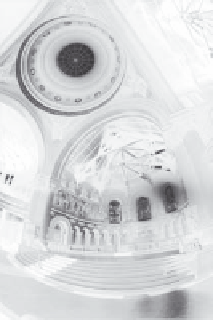Graphics Reference
In-Depth Information
6.1.5 Tone Mapping: Displaying HDR Images
Acquiring an HDR image is, in some sense, only part of the battle. The prob-
lem of how to display a HDR image on a low dynamic range display remains.
This process is known as
tone mapping
, a term that came out of photography.
Strictly speaking, tone mapping refers to mapping the density of a developed neg-
ative to the density of a finished print (print density is known as “tone”). The
problem is not trivial, as photographic film typically has a much higher dynamic
range than print media. In computer graphics, tone mapping generally refers to
the process of reducing the dynamic range of an image while preserving detail
in visually important parts of the image. Tone mapping is an active research field
in itself. Because it has an artistic aspect, there is no “best” way to do it. Debevec
and Malik enlisted the help of Greg Ward for the problem of tone mapping their
captured HDR images. Figure 6.4 illustrates some of the results of rendering a
particular HDR image captured inside of a church. Figure 6.4(a) shows a linearly
mapped image, which displays only a small fraction of the dynamic range (the
YCC encoding used for generating the image does perform a limited amount of
dynamic range reduction). Figures 6.4(b) and (c) contain tone-mapped results;
part (c) includes some perception-based adjustments, including the simulation of
(a)
(b)
(c)
Figure 6.4
A high dynamic range image of the inside of a church. Displaying the image becomes a
challenge, as it has a greater range than the display medium. (a) HDR converted to Kodak's
PhotoCD output, which uses YCC encoding. (b) Tone-mapped HDR image. (c) Tone-
mapped HDR image with modifications to simulate human perception. Note the glare
around the bright windows. The tone mapping algorithm used for these images is described
in [Ward Larson et al. 97]. (From [Debevec and Malik 97] c
1997 ACM, Inc. Included
here by permission.) (See Color Plate VIII.)










